Child Labor Through the Human Rights Perspective: JURI 3706
VerifiedAdded on 2023/01/19
|16
|4934
|85
Essay
AI Summary
This essay examines child labor as a significant human rights issue, exploring its prevalence, particularly in developing countries. It discusses the exploitation of children in various forms of labor, the detrimental effects on their physical and emotional well-being, and the legal issues involved. The paper highlights the interconnection between poverty and child labor, emphasizing how economic constraints compel families to involve their children in work. It also analyzes a rights-based approach to child labor, the challenges in defining and addressing it globally, and the specific situation in the United States, including the exploitation of child farmworkers. The essay underscores the need for nuanced policies and community-targeted programs to protect children's rights and provide them with opportunities for education and a better future.
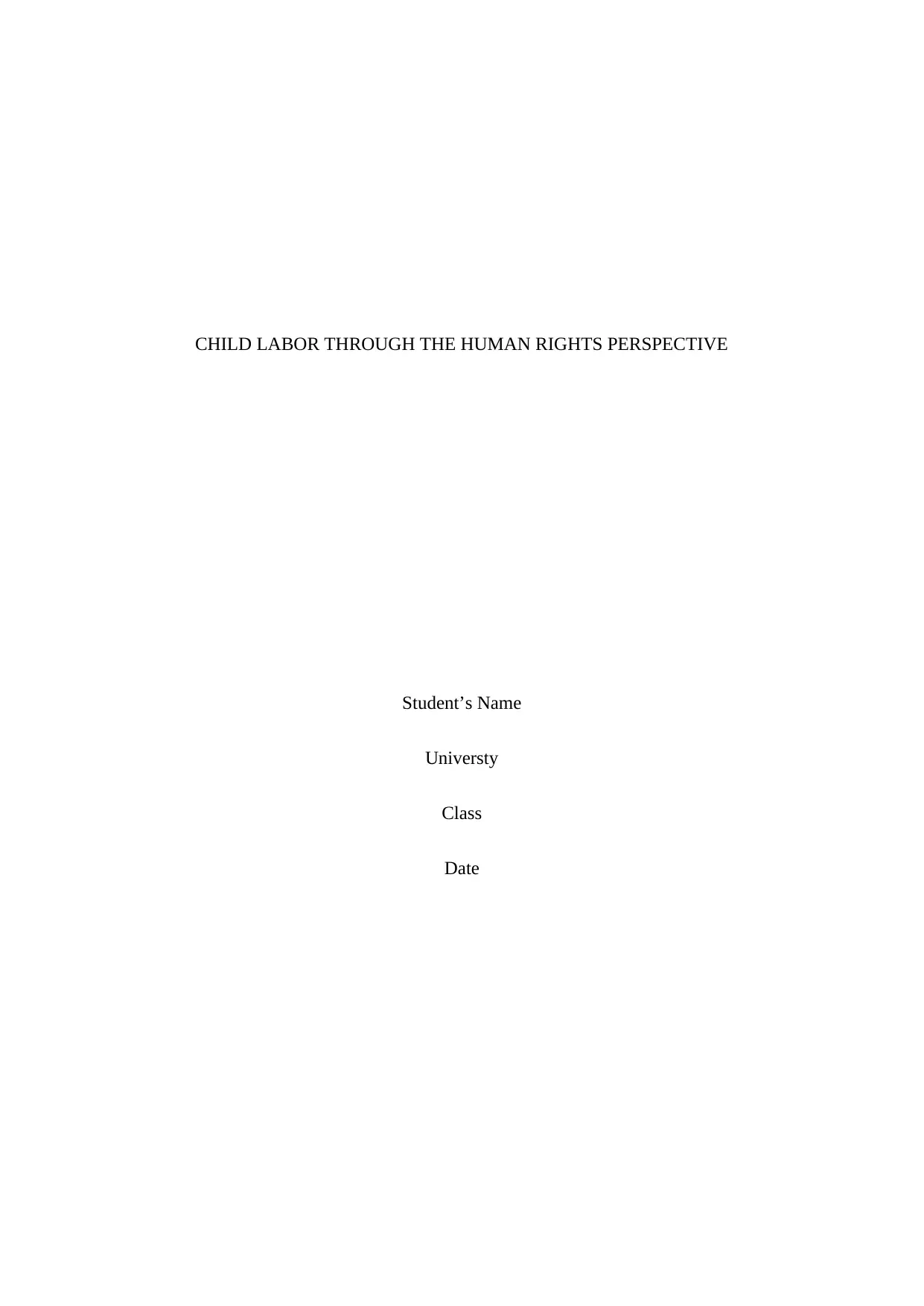
CHILD LABOR THROUGH THE HUMAN RIGHTS PERSPECTIVE
Student’s Name
Universty
Class
Date
Student’s Name
Universty
Class
Date
Paraphrase This Document
Need a fresh take? Get an instant paraphrase of this document with our AI Paraphraser
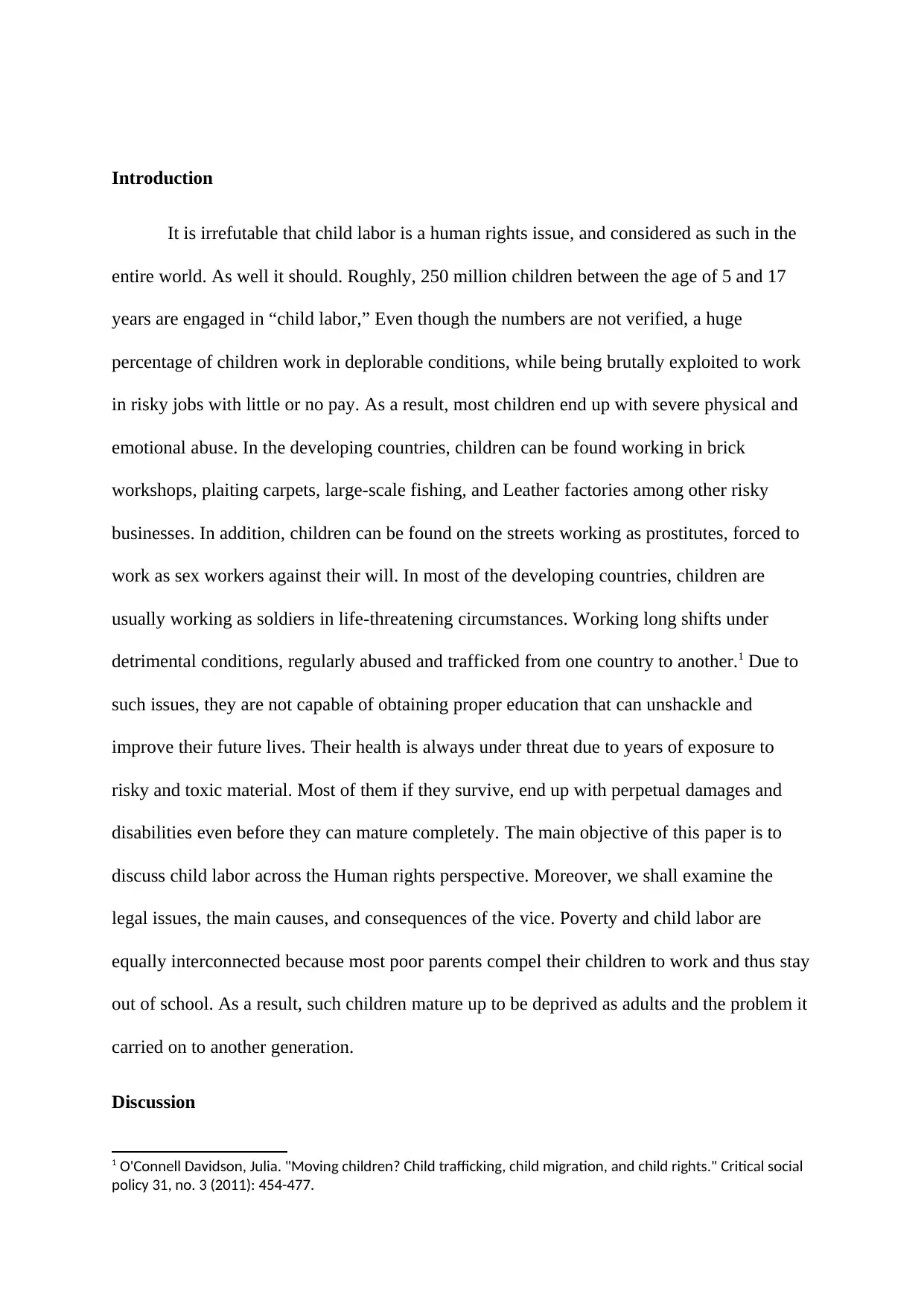
Introduction
It is irrefutable that child labor is a human rights issue, and considered as such in the
entire world. As well it should. Roughly, 250 million children between the age of 5 and 17
years are engaged in “child labor,” Even though the numbers are not verified, a huge
percentage of children work in deplorable conditions, while being brutally exploited to work
in risky jobs with little or no pay. As a result, most children end up with severe physical and
emotional abuse. In the developing countries, children can be found working in brick
workshops, plaiting carpets, large-scale fishing, and Leather factories among other risky
businesses. In addition, children can be found on the streets working as prostitutes, forced to
work as sex workers against their will. In most of the developing countries, children are
usually working as soldiers in life-threatening circumstances. Working long shifts under
detrimental conditions, regularly abused and trafficked from one country to another.1 Due to
such issues, they are not capable of obtaining proper education that can unshackle and
improve their future lives. Their health is always under threat due to years of exposure to
risky and toxic material. Most of them if they survive, end up with perpetual damages and
disabilities even before they can mature completely. The main objective of this paper is to
discuss child labor across the Human rights perspective. Moreover, we shall examine the
legal issues, the main causes, and consequences of the vice. Poverty and child labor are
equally interconnected because most poor parents compel their children to work and thus stay
out of school. As a result, such children mature up to be deprived as adults and the problem it
carried on to another generation.
Discussion
1 O'Connell Davidson, Julia. "Moving children? Child trafficking, child migration, and child rights." Critical social
policy 31, no. 3 (2011): 454-477.
It is irrefutable that child labor is a human rights issue, and considered as such in the
entire world. As well it should. Roughly, 250 million children between the age of 5 and 17
years are engaged in “child labor,” Even though the numbers are not verified, a huge
percentage of children work in deplorable conditions, while being brutally exploited to work
in risky jobs with little or no pay. As a result, most children end up with severe physical and
emotional abuse. In the developing countries, children can be found working in brick
workshops, plaiting carpets, large-scale fishing, and Leather factories among other risky
businesses. In addition, children can be found on the streets working as prostitutes, forced to
work as sex workers against their will. In most of the developing countries, children are
usually working as soldiers in life-threatening circumstances. Working long shifts under
detrimental conditions, regularly abused and trafficked from one country to another.1 Due to
such issues, they are not capable of obtaining proper education that can unshackle and
improve their future lives. Their health is always under threat due to years of exposure to
risky and toxic material. Most of them if they survive, end up with perpetual damages and
disabilities even before they can mature completely. The main objective of this paper is to
discuss child labor across the Human rights perspective. Moreover, we shall examine the
legal issues, the main causes, and consequences of the vice. Poverty and child labor are
equally interconnected because most poor parents compel their children to work and thus stay
out of school. As a result, such children mature up to be deprived as adults and the problem it
carried on to another generation.
Discussion
1 O'Connell Davidson, Julia. "Moving children? Child trafficking, child migration, and child rights." Critical social
policy 31, no. 3 (2011): 454-477.
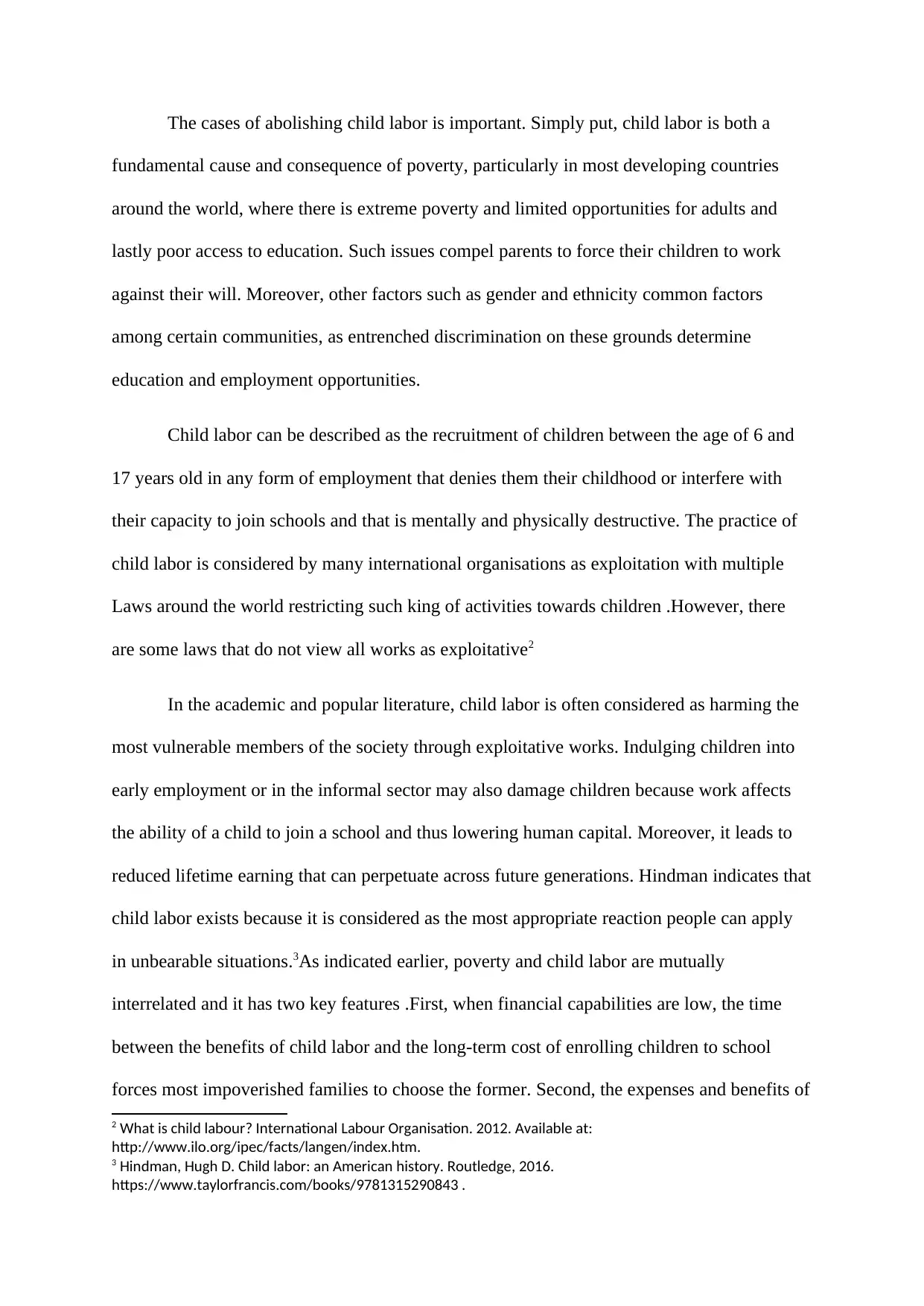
The cases of abolishing child labor is important. Simply put, child labor is both a
fundamental cause and consequence of poverty, particularly in most developing countries
around the world, where there is extreme poverty and limited opportunities for adults and
lastly poor access to education. Such issues compel parents to force their children to work
against their will. Moreover, other factors such as gender and ethnicity common factors
among certain communities, as entrenched discrimination on these grounds determine
education and employment opportunities.
Child labor can be described as the recruitment of children between the age of 6 and
17 years old in any form of employment that denies them their childhood or interfere with
their capacity to join schools and that is mentally and physically destructive. The practice of
child labor is considered by many international organisations as exploitation with multiple
Laws around the world restricting such king of activities towards children .However, there
are some laws that do not view all works as exploitative2
In the academic and popular literature, child labor is often considered as harming the
most vulnerable members of the society through exploitative works. Indulging children into
early employment or in the informal sector may also damage children because work affects
the ability of a child to join a school and thus lowering human capital. Moreover, it leads to
reduced lifetime earning that can perpetuate across future generations. Hindman indicates that
child labor exists because it is considered as the most appropriate reaction people can apply
in unbearable situations.3As indicated earlier, poverty and child labor are mutually
interrelated and it has two key features .First, when financial capabilities are low, the time
between the benefits of child labor and the long-term cost of enrolling children to school
forces most impoverished families to choose the former. Second, the expenses and benefits of
2 What is child labour? International Labour Organisation. 2012. Available at:
http://www.ilo.org/ipec/facts/langen/index.htm.
3 Hindman, Hugh D. Child labor: an American history. Routledge, 2016.
https://www.taylorfrancis.com/books/9781315290843 .
fundamental cause and consequence of poverty, particularly in most developing countries
around the world, where there is extreme poverty and limited opportunities for adults and
lastly poor access to education. Such issues compel parents to force their children to work
against their will. Moreover, other factors such as gender and ethnicity common factors
among certain communities, as entrenched discrimination on these grounds determine
education and employment opportunities.
Child labor can be described as the recruitment of children between the age of 6 and
17 years old in any form of employment that denies them their childhood or interfere with
their capacity to join schools and that is mentally and physically destructive. The practice of
child labor is considered by many international organisations as exploitation with multiple
Laws around the world restricting such king of activities towards children .However, there
are some laws that do not view all works as exploitative2
In the academic and popular literature, child labor is often considered as harming the
most vulnerable members of the society through exploitative works. Indulging children into
early employment or in the informal sector may also damage children because work affects
the ability of a child to join a school and thus lowering human capital. Moreover, it leads to
reduced lifetime earning that can perpetuate across future generations. Hindman indicates that
child labor exists because it is considered as the most appropriate reaction people can apply
in unbearable situations.3As indicated earlier, poverty and child labor are mutually
interrelated and it has two key features .First, when financial capabilities are low, the time
between the benefits of child labor and the long-term cost of enrolling children to school
forces most impoverished families to choose the former. Second, the expenses and benefits of
2 What is child labour? International Labour Organisation. 2012. Available at:
http://www.ilo.org/ipec/facts/langen/index.htm.
3 Hindman, Hugh D. Child labor: an American history. Routledge, 2016.
https://www.taylorfrancis.com/books/9781315290843 .
⊘ This is a preview!⊘
Do you want full access?
Subscribe today to unlock all pages.

Trusted by 1+ million students worldwide
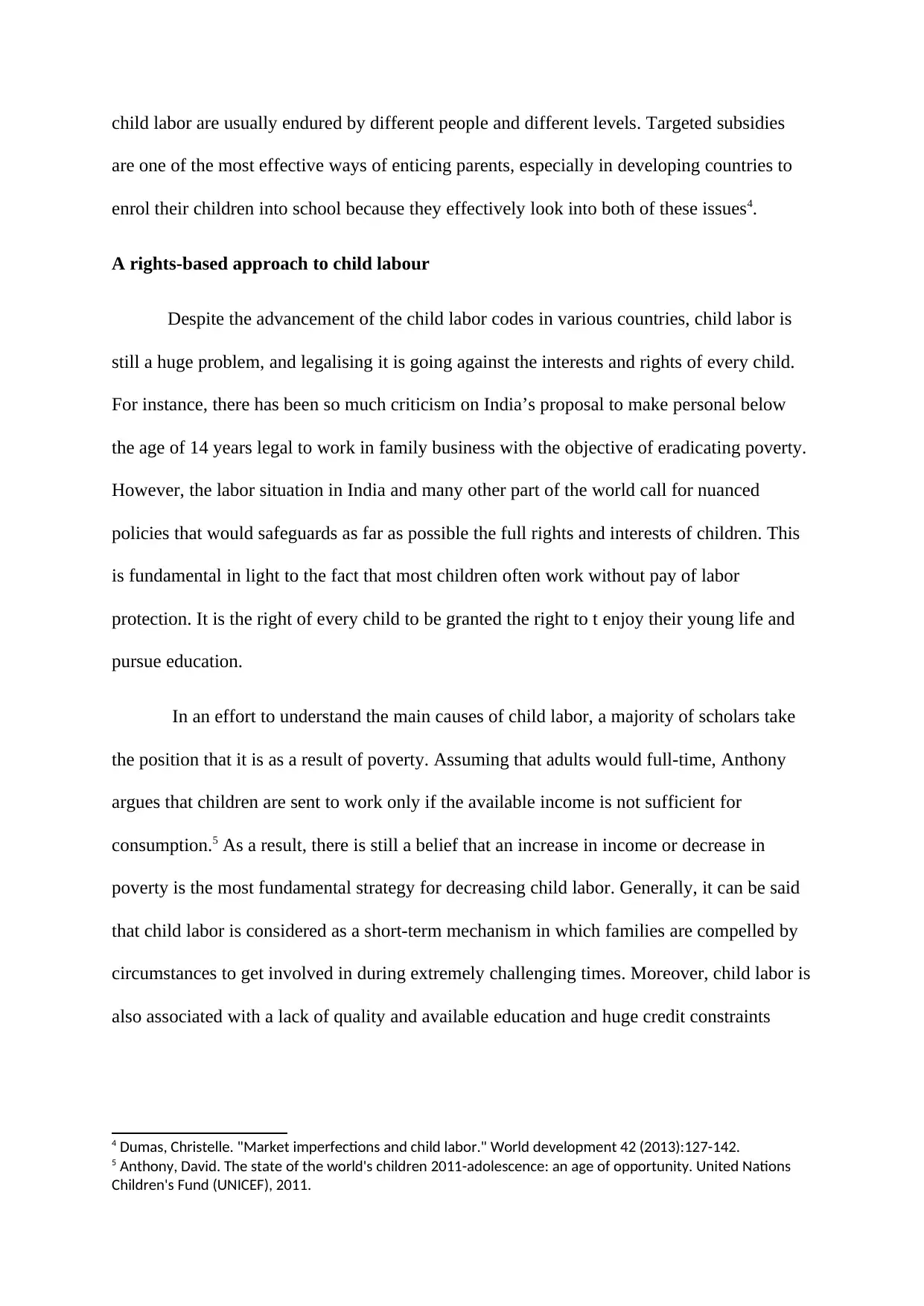
child labor are usually endured by different people and different levels. Targeted subsidies
are one of the most effective ways of enticing parents, especially in developing countries to
enrol their children into school because they effectively look into both of these issues4.
A rights-based approach to child labour
Despite the advancement of the child labor codes in various countries, child labor is
still a huge problem, and legalising it is going against the interests and rights of every child.
For instance, there has been so much criticism on India’s proposal to make personal below
the age of 14 years legal to work in family business with the objective of eradicating poverty.
However, the labor situation in India and many other part of the world call for nuanced
policies that would safeguards as far as possible the full rights and interests of children. This
is fundamental in light to the fact that most children often work without pay of labor
protection. It is the right of every child to be granted the right to t enjoy their young life and
pursue education.
In an effort to understand the main causes of child labor, a majority of scholars take
the position that it is as a result of poverty. Assuming that adults would full-time, Anthony
argues that children are sent to work only if the available income is not sufficient for
consumption.5 As a result, there is still a belief that an increase in income or decrease in
poverty is the most fundamental strategy for decreasing child labor. Generally, it can be said
that child labor is considered as a short-term mechanism in which families are compelled by
circumstances to get involved in during extremely challenging times. Moreover, child labor is
also associated with a lack of quality and available education and huge credit constraints
4 Dumas, Christelle. "Market imperfections and child labor." World development 42 (2013):127-142.
5 Anthony, David. The state of the world's children 2011-adolescence: an age of opportunity. United Nations
Children's Fund (UNICEF), 2011.
are one of the most effective ways of enticing parents, especially in developing countries to
enrol their children into school because they effectively look into both of these issues4.
A rights-based approach to child labour
Despite the advancement of the child labor codes in various countries, child labor is
still a huge problem, and legalising it is going against the interests and rights of every child.
For instance, there has been so much criticism on India’s proposal to make personal below
the age of 14 years legal to work in family business with the objective of eradicating poverty.
However, the labor situation in India and many other part of the world call for nuanced
policies that would safeguards as far as possible the full rights and interests of children. This
is fundamental in light to the fact that most children often work without pay of labor
protection. It is the right of every child to be granted the right to t enjoy their young life and
pursue education.
In an effort to understand the main causes of child labor, a majority of scholars take
the position that it is as a result of poverty. Assuming that adults would full-time, Anthony
argues that children are sent to work only if the available income is not sufficient for
consumption.5 As a result, there is still a belief that an increase in income or decrease in
poverty is the most fundamental strategy for decreasing child labor. Generally, it can be said
that child labor is considered as a short-term mechanism in which families are compelled by
circumstances to get involved in during extremely challenging times. Moreover, child labor is
also associated with a lack of quality and available education and huge credit constraints
4 Dumas, Christelle. "Market imperfections and child labor." World development 42 (2013):127-142.
5 Anthony, David. The state of the world's children 2011-adolescence: an age of opportunity. United Nations
Children's Fund (UNICEF), 2011.
Paraphrase This Document
Need a fresh take? Get an instant paraphrase of this document with our AI Paraphraser
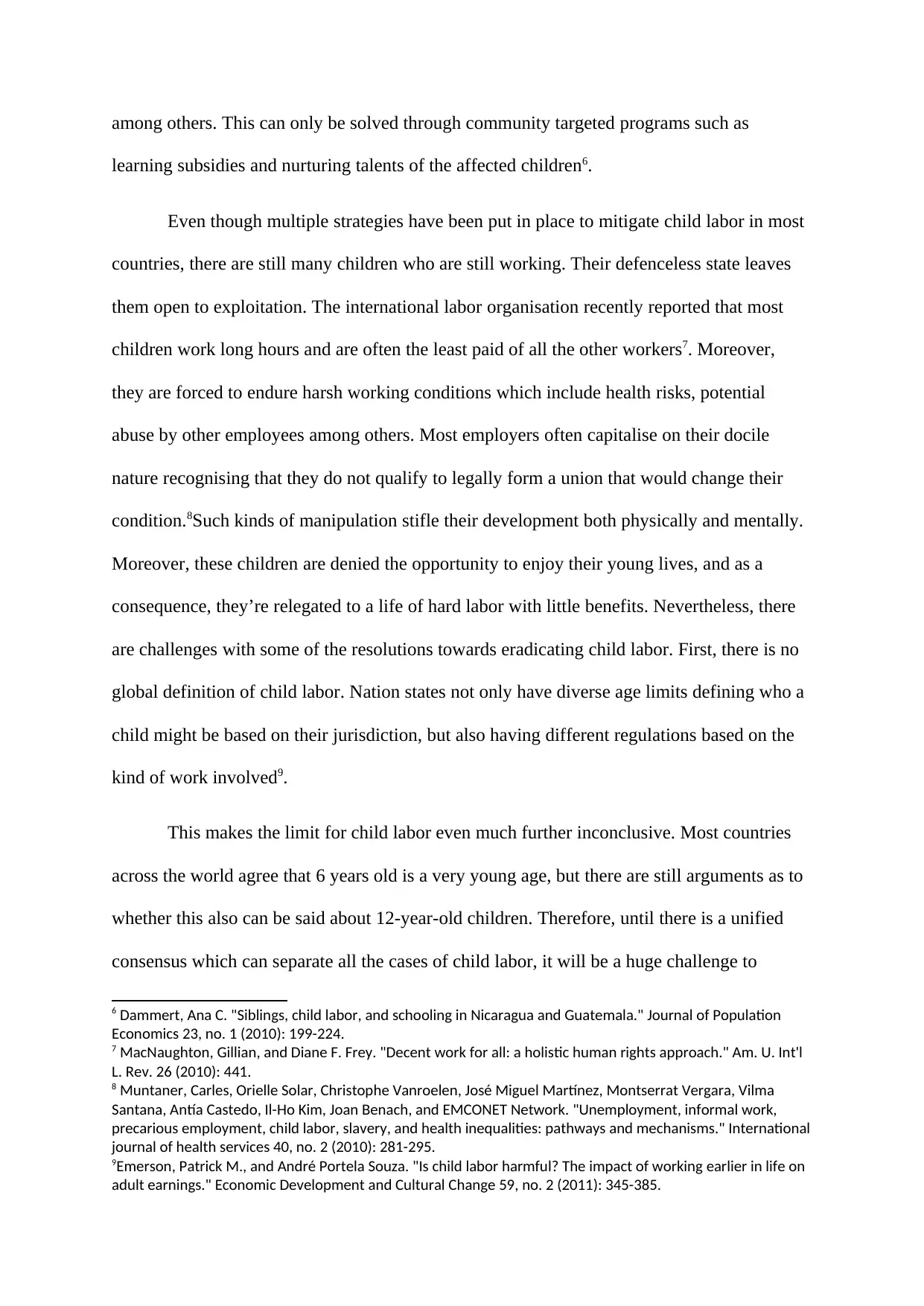
among others. This can only be solved through community targeted programs such as
learning subsidies and nurturing talents of the affected children6.
Even though multiple strategies have been put in place to mitigate child labor in most
countries, there are still many children who are still working. Their defenceless state leaves
them open to exploitation. The international labor organisation recently reported that most
children work long hours and are often the least paid of all the other workers7. Moreover,
they are forced to endure harsh working conditions which include health risks, potential
abuse by other employees among others. Most employers often capitalise on their docile
nature recognising that they do not qualify to legally form a union that would change their
condition.8Such kinds of manipulation stifle their development both physically and mentally.
Moreover, these children are denied the opportunity to enjoy their young lives, and as a
consequence, they’re relegated to a life of hard labor with little benefits. Nevertheless, there
are challenges with some of the resolutions towards eradicating child labor. First, there is no
global definition of child labor. Nation states not only have diverse age limits defining who a
child might be based on their jurisdiction, but also having different regulations based on the
kind of work involved9.
This makes the limit for child labor even much further inconclusive. Most countries
across the world agree that 6 years old is a very young age, but there are still arguments as to
whether this also can be said about 12-year-old children. Therefore, until there is a unified
consensus which can separate all the cases of child labor, it will be a huge challenge to
6 Dammert, Ana C. "Siblings, child labor, and schooling in Nicaragua and Guatemala." Journal of Population
Economics 23, no. 1 (2010): 199-224.
7 MacNaughton, Gillian, and Diane F. Frey. "Decent work for all: a holistic human rights approach." Am. U. Int'l
L. Rev. 26 (2010): 441.
8 Muntaner, Carles, Orielle Solar, Christophe Vanroelen, José Miguel Martínez, Montserrat Vergara, Vilma
Santana, Antía Castedo, Il-Ho Kim, Joan Benach, and EMCONET Network. "Unemployment, informal work,
precarious employment, child labor, slavery, and health inequalities: pathways and mechanisms." International
journal of health services 40, no. 2 (2010): 281-295.
9Emerson, Patrick M., and André Portela Souza. "Is child labor harmful? The impact of working earlier in life on
adult earnings." Economic Development and Cultural Change 59, no. 2 (2011): 345-385.
learning subsidies and nurturing talents of the affected children6.
Even though multiple strategies have been put in place to mitigate child labor in most
countries, there are still many children who are still working. Their defenceless state leaves
them open to exploitation. The international labor organisation recently reported that most
children work long hours and are often the least paid of all the other workers7. Moreover,
they are forced to endure harsh working conditions which include health risks, potential
abuse by other employees among others. Most employers often capitalise on their docile
nature recognising that they do not qualify to legally form a union that would change their
condition.8Such kinds of manipulation stifle their development both physically and mentally.
Moreover, these children are denied the opportunity to enjoy their young lives, and as a
consequence, they’re relegated to a life of hard labor with little benefits. Nevertheless, there
are challenges with some of the resolutions towards eradicating child labor. First, there is no
global definition of child labor. Nation states not only have diverse age limits defining who a
child might be based on their jurisdiction, but also having different regulations based on the
kind of work involved9.
This makes the limit for child labor even much further inconclusive. Most countries
across the world agree that 6 years old is a very young age, but there are still arguments as to
whether this also can be said about 12-year-old children. Therefore, until there is a unified
consensus which can separate all the cases of child labor, it will be a huge challenge to
6 Dammert, Ana C. "Siblings, child labor, and schooling in Nicaragua and Guatemala." Journal of Population
Economics 23, no. 1 (2010): 199-224.
7 MacNaughton, Gillian, and Diane F. Frey. "Decent work for all: a holistic human rights approach." Am. U. Int'l
L. Rev. 26 (2010): 441.
8 Muntaner, Carles, Orielle Solar, Christophe Vanroelen, José Miguel Martínez, Montserrat Vergara, Vilma
Santana, Antía Castedo, Il-Ho Kim, Joan Benach, and EMCONET Network. "Unemployment, informal work,
precarious employment, child labor, slavery, and health inequalities: pathways and mechanisms." International
journal of health services 40, no. 2 (2010): 281-295.
9Emerson, Patrick M., and André Portela Souza. "Is child labor harmful? The impact of working earlier in life on
adult earnings." Economic Development and Cultural Change 59, no. 2 (2011): 345-385.
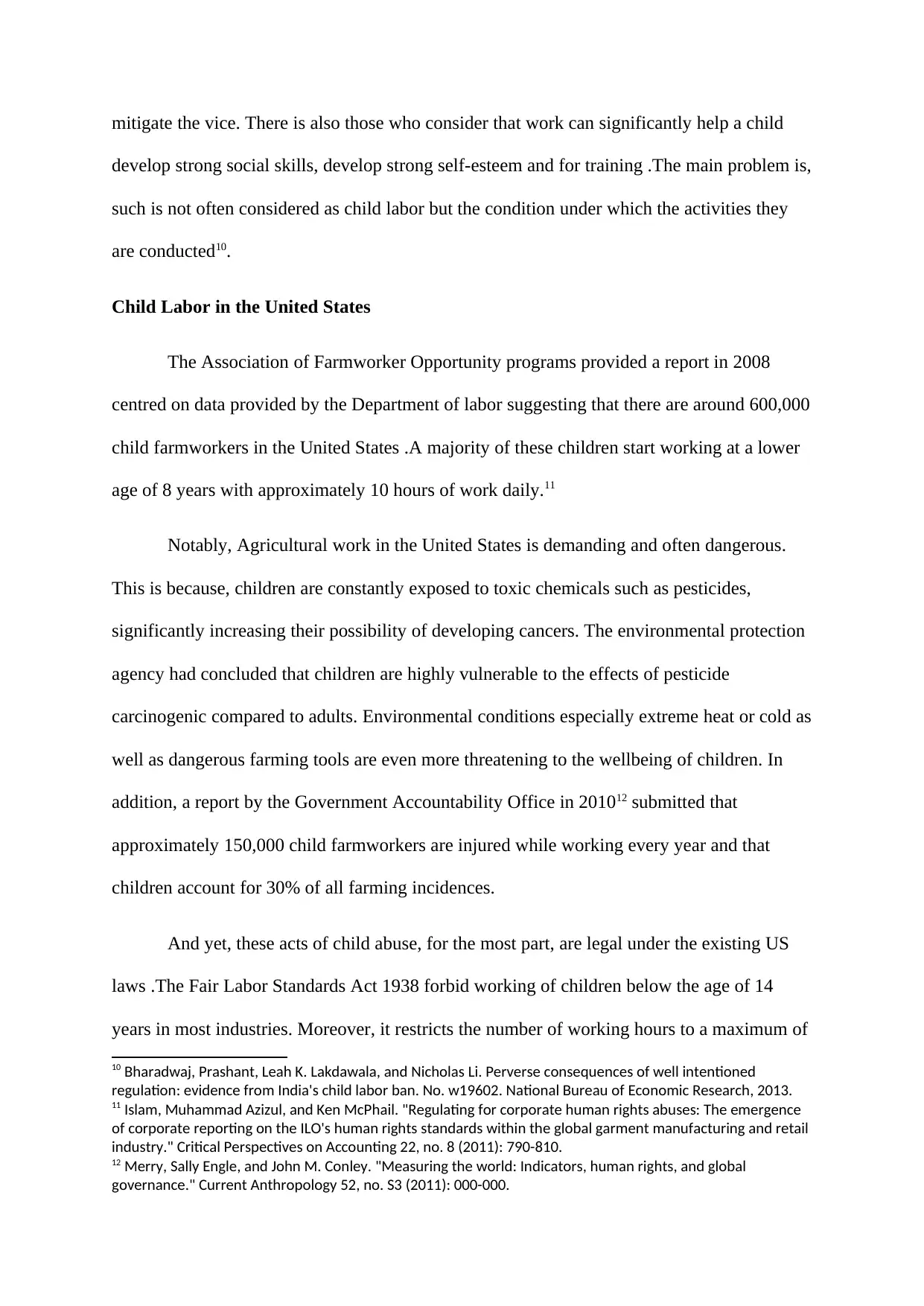
mitigate the vice. There is also those who consider that work can significantly help a child
develop strong social skills, develop strong self-esteem and for training .The main problem is,
such is not often considered as child labor but the condition under which the activities they
are conducted10.
Child Labor in the United States
The Association of Farmworker Opportunity programs provided a report in 2008
centred on data provided by the Department of labor suggesting that there are around 600,000
child farmworkers in the United States .A majority of these children start working at a lower
age of 8 years with approximately 10 hours of work daily.11
Notably, Agricultural work in the United States is demanding and often dangerous.
This is because, children are constantly exposed to toxic chemicals such as pesticides,
significantly increasing their possibility of developing cancers. The environmental protection
agency had concluded that children are highly vulnerable to the effects of pesticide
carcinogenic compared to adults. Environmental conditions especially extreme heat or cold as
well as dangerous farming tools are even more threatening to the wellbeing of children. In
addition, a report by the Government Accountability Office in 201012 submitted that
approximately 150,000 child farmworkers are injured while working every year and that
children account for 30% of all farming incidences.
And yet, these acts of child abuse, for the most part, are legal under the existing US
laws .The Fair Labor Standards Act 1938 forbid working of children below the age of 14
years in most industries. Moreover, it restricts the number of working hours to a maximum of
10 Bharadwaj, Prashant, Leah K. Lakdawala, and Nicholas Li. Perverse consequences of well intentioned
regulation: evidence from India's child labor ban. No. w19602. National Bureau of Economic Research, 2013.
11 Islam, Muhammad Azizul, and Ken McPhail. "Regulating for corporate human rights abuses: The emergence
of corporate reporting on the ILO's human rights standards within the global garment manufacturing and retail
industry." Critical Perspectives on Accounting 22, no. 8 (2011): 790-810.
12 Merry, Sally Engle, and John M. Conley. "Measuring the world: Indicators, human rights, and global
governance." Current Anthropology 52, no. S3 (2011): 000-000.
develop strong social skills, develop strong self-esteem and for training .The main problem is,
such is not often considered as child labor but the condition under which the activities they
are conducted10.
Child Labor in the United States
The Association of Farmworker Opportunity programs provided a report in 2008
centred on data provided by the Department of labor suggesting that there are around 600,000
child farmworkers in the United States .A majority of these children start working at a lower
age of 8 years with approximately 10 hours of work daily.11
Notably, Agricultural work in the United States is demanding and often dangerous.
This is because, children are constantly exposed to toxic chemicals such as pesticides,
significantly increasing their possibility of developing cancers. The environmental protection
agency had concluded that children are highly vulnerable to the effects of pesticide
carcinogenic compared to adults. Environmental conditions especially extreme heat or cold as
well as dangerous farming tools are even more threatening to the wellbeing of children. In
addition, a report by the Government Accountability Office in 201012 submitted that
approximately 150,000 child farmworkers are injured while working every year and that
children account for 30% of all farming incidences.
And yet, these acts of child abuse, for the most part, are legal under the existing US
laws .The Fair Labor Standards Act 1938 forbid working of children below the age of 14
years in most industries. Moreover, it restricts the number of working hours to a maximum of
10 Bharadwaj, Prashant, Leah K. Lakdawala, and Nicholas Li. Perverse consequences of well intentioned
regulation: evidence from India's child labor ban. No. w19602. National Bureau of Economic Research, 2013.
11 Islam, Muhammad Azizul, and Ken McPhail. "Regulating for corporate human rights abuses: The emergence
of corporate reporting on the ILO's human rights standards within the global garment manufacturing and retail
industry." Critical Perspectives on Accounting 22, no. 8 (2011): 790-810.
12 Merry, Sally Engle, and John M. Conley. "Measuring the world: Indicators, human rights, and global
governance." Current Anthropology 52, no. S3 (2011): 000-000.
⊘ This is a preview!⊘
Do you want full access?
Subscribe today to unlock all pages.

Trusted by 1+ million students worldwide
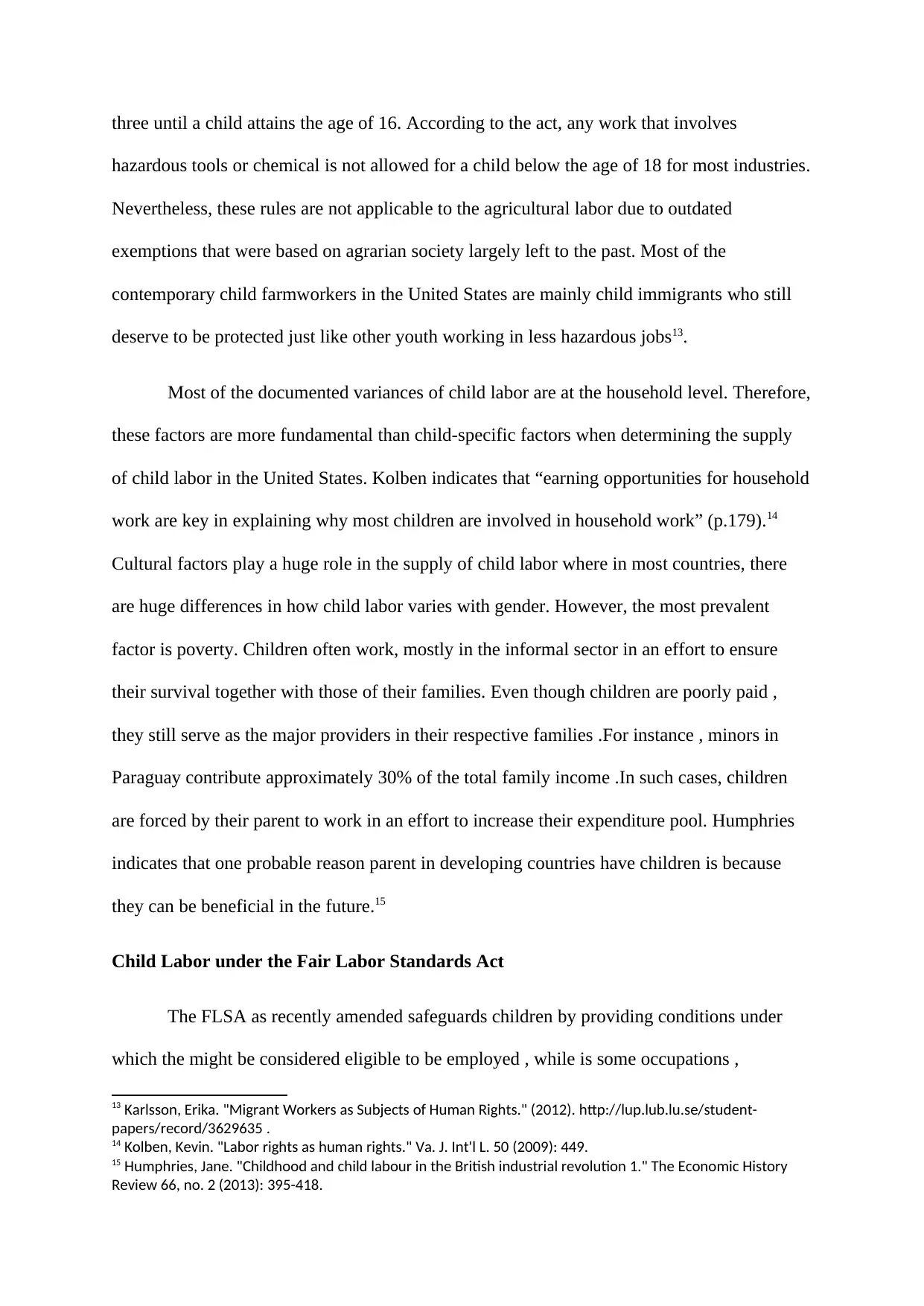
three until a child attains the age of 16. According to the act, any work that involves
hazardous tools or chemical is not allowed for a child below the age of 18 for most industries.
Nevertheless, these rules are not applicable to the agricultural labor due to outdated
exemptions that were based on agrarian society largely left to the past. Most of the
contemporary child farmworkers in the United States are mainly child immigrants who still
deserve to be protected just like other youth working in less hazardous jobs13.
Most of the documented variances of child labor are at the household level. Therefore,
these factors are more fundamental than child-specific factors when determining the supply
of child labor in the United States. Kolben indicates that “earning opportunities for household
work are key in explaining why most children are involved in household work” (p.179).14
Cultural factors play a huge role in the supply of child labor where in most countries, there
are huge differences in how child labor varies with gender. However, the most prevalent
factor is poverty. Children often work, mostly in the informal sector in an effort to ensure
their survival together with those of their families. Even though children are poorly paid ,
they still serve as the major providers in their respective families .For instance , minors in
Paraguay contribute approximately 30% of the total family income .In such cases, children
are forced by their parent to work in an effort to increase their expenditure pool. Humphries
indicates that one probable reason parent in developing countries have children is because
they can be beneficial in the future.15
Child Labor under the Fair Labor Standards Act
The FLSA as recently amended safeguards children by providing conditions under
which the might be considered eligible to be employed , while is some occupations ,
13 Karlsson, Erika. "Migrant Workers as Subjects of Human Rights." (2012). http://lup.lub.lu.se/student-
papers/record/3629635 .
14 Kolben, Kevin. "Labor rights as human rights." Va. J. Int'l L. 50 (2009): 449.
15 Humphries, Jane. "Childhood and child labour in the British industrial revolution 1." The Economic History
Review 66, no. 2 (2013): 395-418.
hazardous tools or chemical is not allowed for a child below the age of 18 for most industries.
Nevertheless, these rules are not applicable to the agricultural labor due to outdated
exemptions that were based on agrarian society largely left to the past. Most of the
contemporary child farmworkers in the United States are mainly child immigrants who still
deserve to be protected just like other youth working in less hazardous jobs13.
Most of the documented variances of child labor are at the household level. Therefore,
these factors are more fundamental than child-specific factors when determining the supply
of child labor in the United States. Kolben indicates that “earning opportunities for household
work are key in explaining why most children are involved in household work” (p.179).14
Cultural factors play a huge role in the supply of child labor where in most countries, there
are huge differences in how child labor varies with gender. However, the most prevalent
factor is poverty. Children often work, mostly in the informal sector in an effort to ensure
their survival together with those of their families. Even though children are poorly paid ,
they still serve as the major providers in their respective families .For instance , minors in
Paraguay contribute approximately 30% of the total family income .In such cases, children
are forced by their parent to work in an effort to increase their expenditure pool. Humphries
indicates that one probable reason parent in developing countries have children is because
they can be beneficial in the future.15
Child Labor under the Fair Labor Standards Act
The FLSA as recently amended safeguards children by providing conditions under
which the might be considered eligible to be employed , while is some occupations ,
13 Karlsson, Erika. "Migrant Workers as Subjects of Human Rights." (2012). http://lup.lub.lu.se/student-
papers/record/3629635 .
14 Kolben, Kevin. "Labor rights as human rights." Va. J. Int'l L. 50 (2009): 449.
15 Humphries, Jane. "Childhood and child labour in the British industrial revolution 1." The Economic History
Review 66, no. 2 (2013): 395-418.
Paraphrase This Document
Need a fresh take? Get an instant paraphrase of this document with our AI Paraphraser
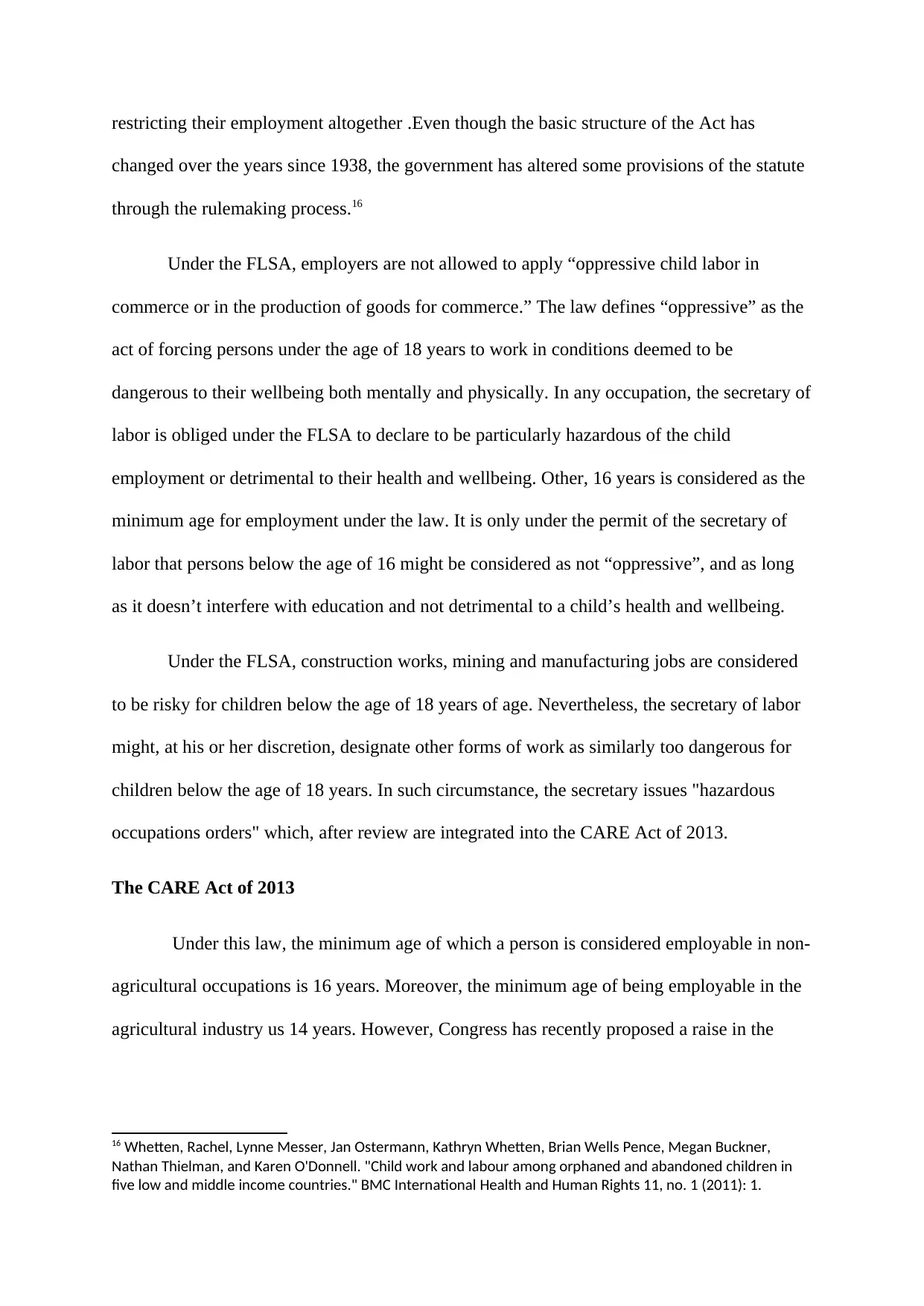
restricting their employment altogether .Even though the basic structure of the Act has
changed over the years since 1938, the government has altered some provisions of the statute
through the rulemaking process.16
Under the FLSA, employers are not allowed to apply “oppressive child labor in
commerce or in the production of goods for commerce.” The law defines “oppressive” as the
act of forcing persons under the age of 18 years to work in conditions deemed to be
dangerous to their wellbeing both mentally and physically. In any occupation, the secretary of
labor is obliged under the FLSA to declare to be particularly hazardous of the child
employment or detrimental to their health and wellbeing. Other, 16 years is considered as the
minimum age for employment under the law. It is only under the permit of the secretary of
labor that persons below the age of 16 might be considered as not “oppressive”, and as long
as it doesn’t interfere with education and not detrimental to a child’s health and wellbeing.
Under the FLSA, construction works, mining and manufacturing jobs are considered
to be risky for children below the age of 18 years of age. Nevertheless, the secretary of labor
might, at his or her discretion, designate other forms of work as similarly too dangerous for
children below the age of 18 years. In such circumstance, the secretary issues "hazardous
occupations orders" which, after review are integrated into the CARE Act of 2013.
The CARE Act of 2013
Under this law, the minimum age of which a person is considered employable in non-
agricultural occupations is 16 years. Moreover, the minimum age of being employable in the
agricultural industry us 14 years. However, Congress has recently proposed a raise in the
16 Whetten, Rachel, Lynne Messer, Jan Ostermann, Kathryn Whetten, Brian Wells Pence, Megan Buckner,
Nathan Thielman, and Karen O'Donnell. "Child work and labour among orphaned and abandoned children in
five low and middle income countries." BMC International Health and Human Rights 11, no. 1 (2011): 1.
changed over the years since 1938, the government has altered some provisions of the statute
through the rulemaking process.16
Under the FLSA, employers are not allowed to apply “oppressive child labor in
commerce or in the production of goods for commerce.” The law defines “oppressive” as the
act of forcing persons under the age of 18 years to work in conditions deemed to be
dangerous to their wellbeing both mentally and physically. In any occupation, the secretary of
labor is obliged under the FLSA to declare to be particularly hazardous of the child
employment or detrimental to their health and wellbeing. Other, 16 years is considered as the
minimum age for employment under the law. It is only under the permit of the secretary of
labor that persons below the age of 16 might be considered as not “oppressive”, and as long
as it doesn’t interfere with education and not detrimental to a child’s health and wellbeing.
Under the FLSA, construction works, mining and manufacturing jobs are considered
to be risky for children below the age of 18 years of age. Nevertheless, the secretary of labor
might, at his or her discretion, designate other forms of work as similarly too dangerous for
children below the age of 18 years. In such circumstance, the secretary issues "hazardous
occupations orders" which, after review are integrated into the CARE Act of 2013.
The CARE Act of 2013
Under this law, the minimum age of which a person is considered employable in non-
agricultural occupations is 16 years. Moreover, the minimum age of being employable in the
agricultural industry us 14 years. However, Congress has recently proposed a raise in the
16 Whetten, Rachel, Lynne Messer, Jan Ostermann, Kathryn Whetten, Brian Wells Pence, Megan Buckner,
Nathan Thielman, and Karen O'Donnell. "Child work and labour among orphaned and abandoned children in
five low and middle income countries." BMC International Health and Human Rights 11, no. 1 (2011): 1.
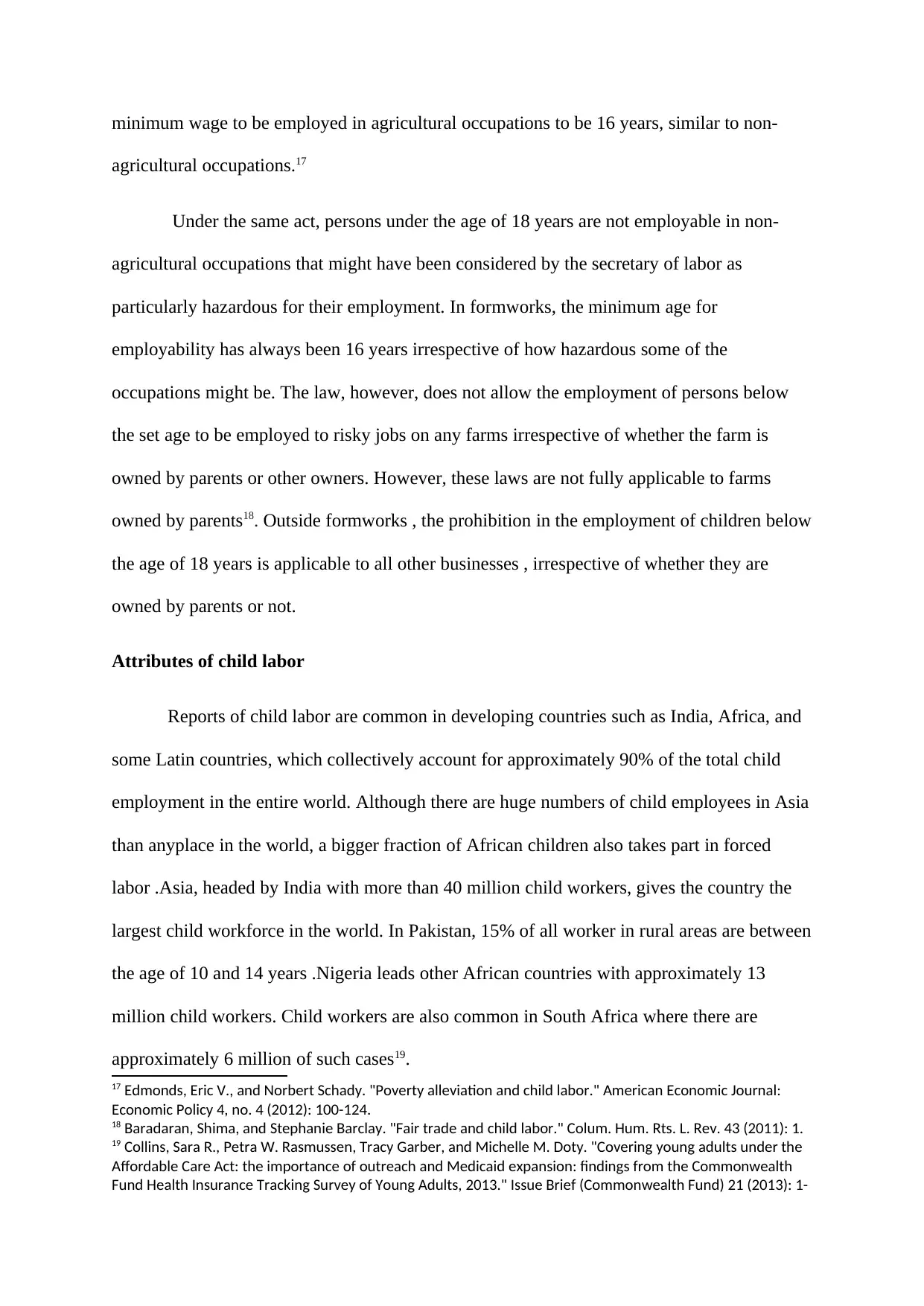
minimum wage to be employed in agricultural occupations to be 16 years, similar to non-
agricultural occupations.17
Under the same act, persons under the age of 18 years are not employable in non-
agricultural occupations that might have been considered by the secretary of labor as
particularly hazardous for their employment. In formworks, the minimum age for
employability has always been 16 years irrespective of how hazardous some of the
occupations might be. The law, however, does not allow the employment of persons below
the set age to be employed to risky jobs on any farms irrespective of whether the farm is
owned by parents or other owners. However, these laws are not fully applicable to farms
owned by parents18. Outside formworks , the prohibition in the employment of children below
the age of 18 years is applicable to all other businesses , irrespective of whether they are
owned by parents or not.
Attributes of child labor
Reports of child labor are common in developing countries such as India, Africa, and
some Latin countries, which collectively account for approximately 90% of the total child
employment in the entire world. Although there are huge numbers of child employees in Asia
than anyplace in the world, a bigger fraction of African children also takes part in forced
labor .Asia, headed by India with more than 40 million child workers, gives the country the
largest child workforce in the world. In Pakistan, 15% of all worker in rural areas are between
the age of 10 and 14 years .Nigeria leads other African countries with approximately 13
million child workers. Child workers are also common in South Africa where there are
approximately 6 million of such cases19.
17 Edmonds, Eric V., and Norbert Schady. "Poverty alleviation and child labor." American Economic Journal:
Economic Policy 4, no. 4 (2012): 100-124.
18 Baradaran, Shima, and Stephanie Barclay. "Fair trade and child labor." Colum. Hum. Rts. L. Rev. 43 (2011): 1.
19 Collins, Sara R., Petra W. Rasmussen, Tracy Garber, and Michelle M. Doty. "Covering young adults under the
Affordable Care Act: the importance of outreach and Medicaid expansion: findings from the Commonwealth
Fund Health Insurance Tracking Survey of Young Adults, 2013." Issue Brief (Commonwealth Fund) 21 (2013): 1-
agricultural occupations.17
Under the same act, persons under the age of 18 years are not employable in non-
agricultural occupations that might have been considered by the secretary of labor as
particularly hazardous for their employment. In formworks, the minimum age for
employability has always been 16 years irrespective of how hazardous some of the
occupations might be. The law, however, does not allow the employment of persons below
the set age to be employed to risky jobs on any farms irrespective of whether the farm is
owned by parents or other owners. However, these laws are not fully applicable to farms
owned by parents18. Outside formworks , the prohibition in the employment of children below
the age of 18 years is applicable to all other businesses , irrespective of whether they are
owned by parents or not.
Attributes of child labor
Reports of child labor are common in developing countries such as India, Africa, and
some Latin countries, which collectively account for approximately 90% of the total child
employment in the entire world. Although there are huge numbers of child employees in Asia
than anyplace in the world, a bigger fraction of African children also takes part in forced
labor .Asia, headed by India with more than 40 million child workers, gives the country the
largest child workforce in the world. In Pakistan, 15% of all worker in rural areas are between
the age of 10 and 14 years .Nigeria leads other African countries with approximately 13
million child workers. Child workers are also common in South Africa where there are
approximately 6 million of such cases19.
17 Edmonds, Eric V., and Norbert Schady. "Poverty alleviation and child labor." American Economic Journal:
Economic Policy 4, no. 4 (2012): 100-124.
18 Baradaran, Shima, and Stephanie Barclay. "Fair trade and child labor." Colum. Hum. Rts. L. Rev. 43 (2011): 1.
19 Collins, Sara R., Petra W. Rasmussen, Tracy Garber, and Michelle M. Doty. "Covering young adults under the
Affordable Care Act: the importance of outreach and Medicaid expansion: findings from the Commonwealth
Fund Health Insurance Tracking Survey of Young Adults, 2013." Issue Brief (Commonwealth Fund) 21 (2013): 1-
⊘ This is a preview!⊘
Do you want full access?
Subscribe today to unlock all pages.

Trusted by 1+ million students worldwide
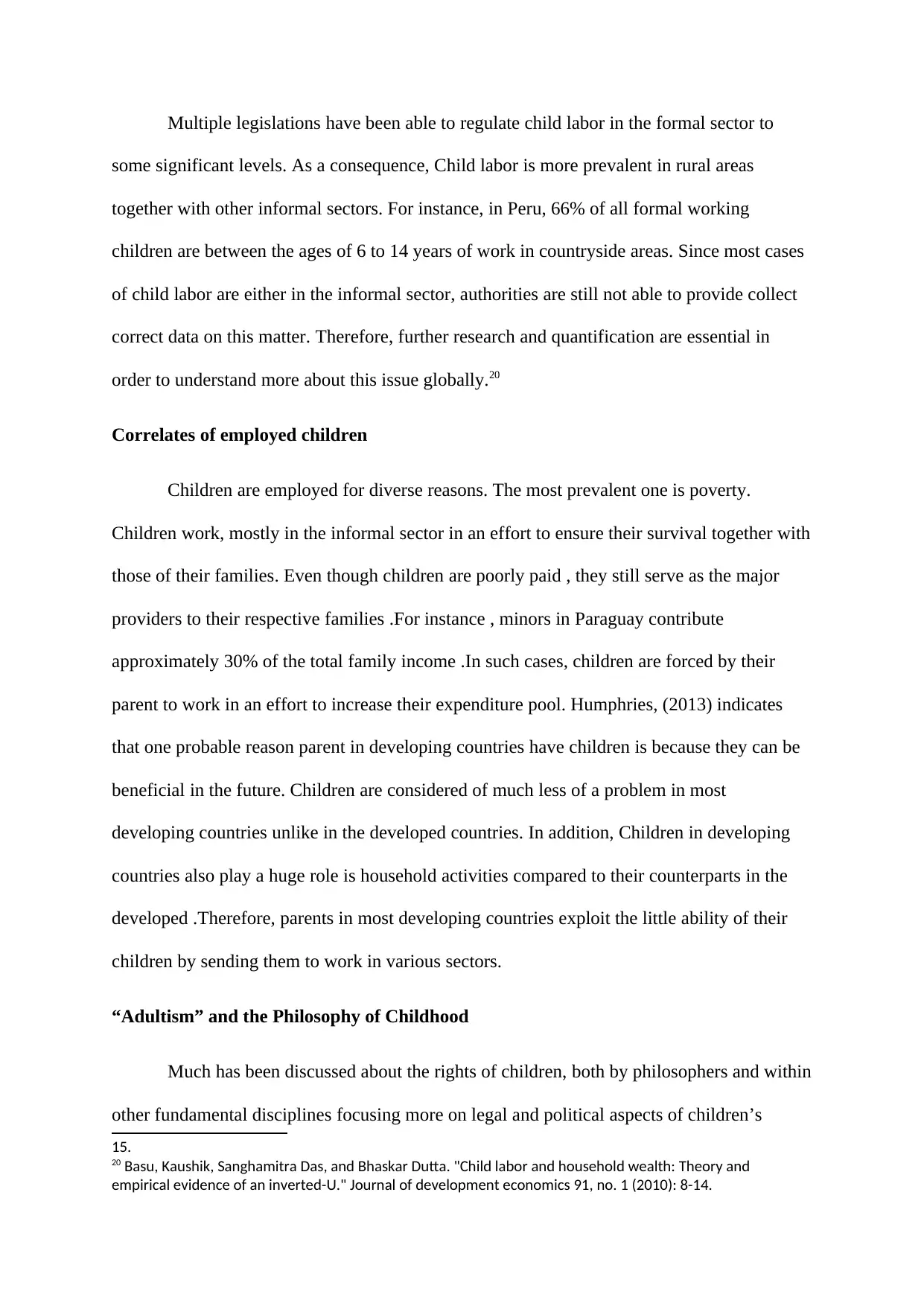
Multiple legislations have been able to regulate child labor in the formal sector to
some significant levels. As a consequence, Child labor is more prevalent in rural areas
together with other informal sectors. For instance, in Peru, 66% of all formal working
children are between the ages of 6 to 14 years of work in countryside areas. Since most cases
of child labor are either in the informal sector, authorities are still not able to provide collect
correct data on this matter. Therefore, further research and quantification are essential in
order to understand more about this issue globally.20
Correlates of employed children
Children are employed for diverse reasons. The most prevalent one is poverty.
Children work, mostly in the informal sector in an effort to ensure their survival together with
those of their families. Even though children are poorly paid , they still serve as the major
providers to their respective families .For instance , minors in Paraguay contribute
approximately 30% of the total family income .In such cases, children are forced by their
parent to work in an effort to increase their expenditure pool. Humphries, (2013) indicates
that one probable reason parent in developing countries have children is because they can be
beneficial in the future. Children are considered of much less of a problem in most
developing countries unlike in the developed countries. In addition, Children in developing
countries also play a huge role is household activities compared to their counterparts in the
developed .Therefore, parents in most developing countries exploit the little ability of their
children by sending them to work in various sectors.
“Adultism” and the Philosophy of Childhood
Much has been discussed about the rights of children, both by philosophers and within
other fundamental disciplines focusing more on legal and political aspects of children’s
15.
20 Basu, Kaushik, Sanghamitra Das, and Bhaskar Dutta. "Child labor and household wealth: Theory and
empirical evidence of an inverted-U." Journal of development economics 91, no. 1 (2010): 8-14.
some significant levels. As a consequence, Child labor is more prevalent in rural areas
together with other informal sectors. For instance, in Peru, 66% of all formal working
children are between the ages of 6 to 14 years of work in countryside areas. Since most cases
of child labor are either in the informal sector, authorities are still not able to provide collect
correct data on this matter. Therefore, further research and quantification are essential in
order to understand more about this issue globally.20
Correlates of employed children
Children are employed for diverse reasons. The most prevalent one is poverty.
Children work, mostly in the informal sector in an effort to ensure their survival together with
those of their families. Even though children are poorly paid , they still serve as the major
providers to their respective families .For instance , minors in Paraguay contribute
approximately 30% of the total family income .In such cases, children are forced by their
parent to work in an effort to increase their expenditure pool. Humphries, (2013) indicates
that one probable reason parent in developing countries have children is because they can be
beneficial in the future. Children are considered of much less of a problem in most
developing countries unlike in the developed countries. In addition, Children in developing
countries also play a huge role is household activities compared to their counterparts in the
developed .Therefore, parents in most developing countries exploit the little ability of their
children by sending them to work in various sectors.
“Adultism” and the Philosophy of Childhood
Much has been discussed about the rights of children, both by philosophers and within
other fundamental disciplines focusing more on legal and political aspects of children’s
15.
20 Basu, Kaushik, Sanghamitra Das, and Bhaskar Dutta. "Child labor and household wealth: Theory and
empirical evidence of an inverted-U." Journal of development economics 91, no. 1 (2010): 8-14.
Paraphrase This Document
Need a fresh take? Get an instant paraphrase of this document with our AI Paraphraser
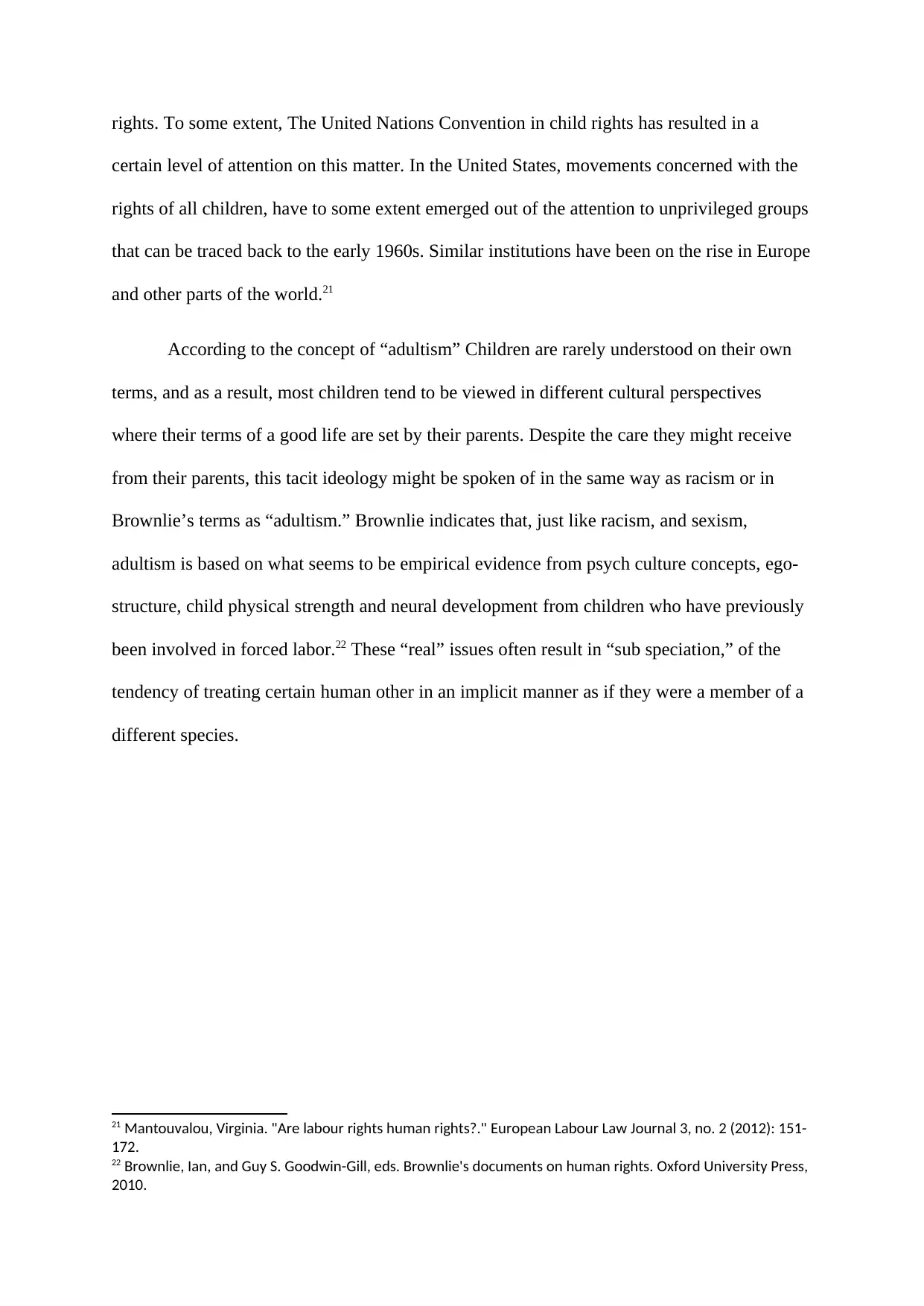
rights. To some extent, The United Nations Convention in child rights has resulted in a
certain level of attention on this matter. In the United States, movements concerned with the
rights of all children, have to some extent emerged out of the attention to unprivileged groups
that can be traced back to the early 1960s. Similar institutions have been on the rise in Europe
and other parts of the world.21
According to the concept of “adultism” Children are rarely understood on their own
terms, and as a result, most children tend to be viewed in different cultural perspectives
where their terms of a good life are set by their parents. Despite the care they might receive
from their parents, this tacit ideology might be spoken of in the same way as racism or in
Brownlie’s terms as “adultism.” Brownlie indicates that, just like racism, and sexism,
adultism is based on what seems to be empirical evidence from psych culture concepts, ego-
structure, child physical strength and neural development from children who have previously
been involved in forced labor.22 These “real” issues often result in “sub speciation,” of the
tendency of treating certain human other in an implicit manner as if they were a member of a
different species.
21 Mantouvalou, Virginia. "Are labour rights human rights?." European Labour Law Journal 3, no. 2 (2012): 151-
172.
22 Brownlie, Ian, and Guy S. Goodwin-Gill, eds. Brownlie's documents on human rights. Oxford University Press,
2010.
certain level of attention on this matter. In the United States, movements concerned with the
rights of all children, have to some extent emerged out of the attention to unprivileged groups
that can be traced back to the early 1960s. Similar institutions have been on the rise in Europe
and other parts of the world.21
According to the concept of “adultism” Children are rarely understood on their own
terms, and as a result, most children tend to be viewed in different cultural perspectives
where their terms of a good life are set by their parents. Despite the care they might receive
from their parents, this tacit ideology might be spoken of in the same way as racism or in
Brownlie’s terms as “adultism.” Brownlie indicates that, just like racism, and sexism,
adultism is based on what seems to be empirical evidence from psych culture concepts, ego-
structure, child physical strength and neural development from children who have previously
been involved in forced labor.22 These “real” issues often result in “sub speciation,” of the
tendency of treating certain human other in an implicit manner as if they were a member of a
different species.
21 Mantouvalou, Virginia. "Are labour rights human rights?." European Labour Law Journal 3, no. 2 (2012): 151-
172.
22 Brownlie, Ian, and Guy S. Goodwin-Gill, eds. Brownlie's documents on human rights. Oxford University Press,
2010.
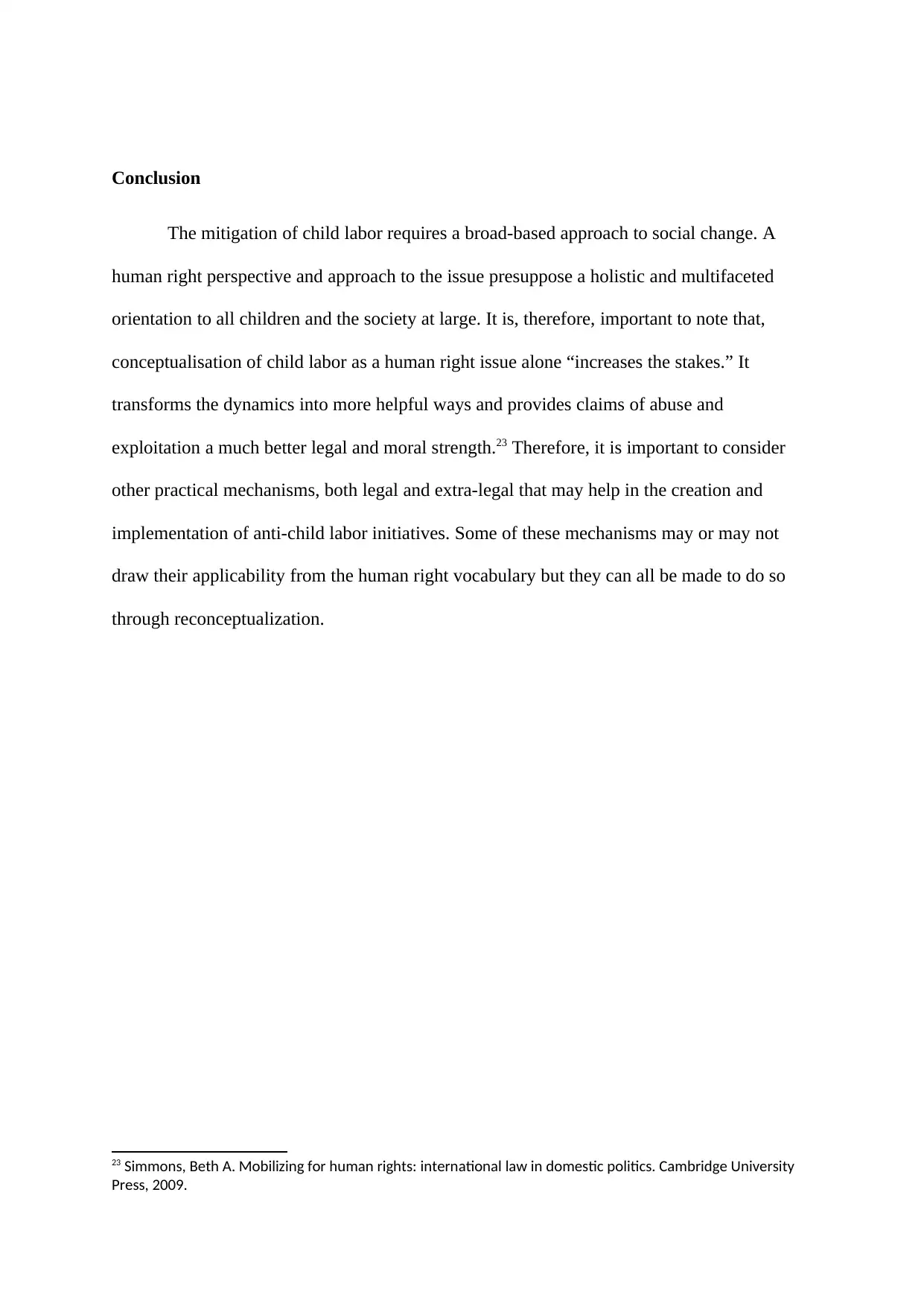
Conclusion
The mitigation of child labor requires a broad-based approach to social change. A
human right perspective and approach to the issue presuppose a holistic and multifaceted
orientation to all children and the society at large. It is, therefore, important to note that,
conceptualisation of child labor as a human right issue alone “increases the stakes.” It
transforms the dynamics into more helpful ways and provides claims of abuse and
exploitation a much better legal and moral strength.23 Therefore, it is important to consider
other practical mechanisms, both legal and extra-legal that may help in the creation and
implementation of anti-child labor initiatives. Some of these mechanisms may or may not
draw their applicability from the human right vocabulary but they can all be made to do so
through reconceptualization.
23 Simmons, Beth A. Mobilizing for human rights: international law in domestic politics. Cambridge University
Press, 2009.
The mitigation of child labor requires a broad-based approach to social change. A
human right perspective and approach to the issue presuppose a holistic and multifaceted
orientation to all children and the society at large. It is, therefore, important to note that,
conceptualisation of child labor as a human right issue alone “increases the stakes.” It
transforms the dynamics into more helpful ways and provides claims of abuse and
exploitation a much better legal and moral strength.23 Therefore, it is important to consider
other practical mechanisms, both legal and extra-legal that may help in the creation and
implementation of anti-child labor initiatives. Some of these mechanisms may or may not
draw their applicability from the human right vocabulary but they can all be made to do so
through reconceptualization.
23 Simmons, Beth A. Mobilizing for human rights: international law in domestic politics. Cambridge University
Press, 2009.
⊘ This is a preview!⊘
Do you want full access?
Subscribe today to unlock all pages.

Trusted by 1+ million students worldwide
1 out of 16
Related Documents
Your All-in-One AI-Powered Toolkit for Academic Success.
+13062052269
info@desklib.com
Available 24*7 on WhatsApp / Email
![[object Object]](/_next/static/media/star-bottom.7253800d.svg)
Unlock your academic potential
Copyright © 2020–2025 A2Z Services. All Rights Reserved. Developed and managed by ZUCOL.





